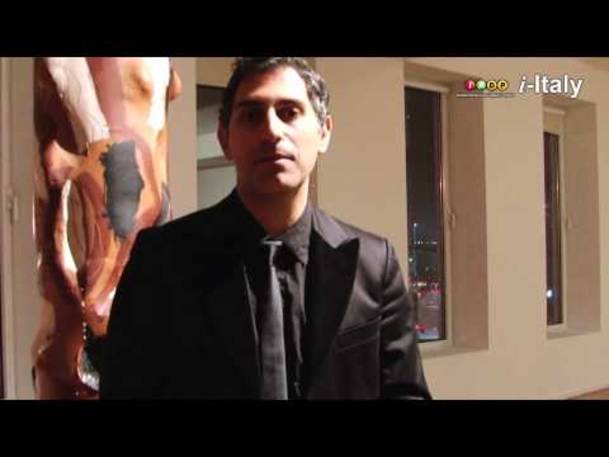


Ambrosino [2] has been painting since the 1950s. An ambitious artist from his humble beginnings, his work has been shown in countless galleries in Naples and other parts of Italy, where his varying motifs and styles displayed hints of genres while simultaneously creating a unique style that merited him recognition as a noteworthy artist demonstrative of his native Campania. His studies in the classics and geology had some influence on his work and development as an artist, and the essence of the rich cultural history of his home environment pervades his metaphoric language on canvas and in 3-D mediums.
Some of Ambrosino’s earlier work exhibits clear “cubist” tendencies; this includes pieces that were exhibited in the First Edition of the National Exhibition for Young Italian Artists, held in Naples in the late 1950s. Following this period, Ambrosino experimented with a Neo-realistic style in large-scale pieces, which portrayed the struggle of the proletariat work so commonly found in southern Italy.
Influences of cubism and impressionism are evident in Ambrosino’s early work. His surrounding environment, the Province of Naples, provided the artist with a plethora of artistic inspiration for the bucolic nature of his painting as well. In the late 1960s Ambrosino made his debut at the UCAI in the Maschio Angioino in Naples, the "Cerreto Guidi" National Biennial Exhibition of Art, and the National Art Exhibition of the Tourist Office of Desenzano on Garda Lake. At barely 30 years old, Ambrosino was recognized at the best participating artist at the Desenzano exhibition.
In 1965 Ambrosino faced a crossroad and he made the most pivotal decision of his life: to fully
dedicate himself to art, abandoning his university studies. This decision allotted the time and focus required to pursue a career as an artist, which panned out beautifully over the next few decades.
The following years were packed with prolific achievements in painting, as Ambrosino traveled to Venezuela to display his work at the Marcos Castillo Gallery of Caracas; and to Milan where his talent for portraying his native land shone forth in his paintings. The essence of quotidian southern Italian life is infused in his canvases; he responds to the flow of life surrounding him, making his work personal yet capable of speaking to the masses about being in touch with the realities of everyday life and how one feels connected to the world which engulfs us. Ambrosino’s ability to portray this connectivity between himself and his world through his painting distinguishes him as a painter completely immersed in his art: the mode of expression and life-giving force propelled him forth.
During the 1970s Ambrosino toured the world—Greece, Turkey, the Soviet Union, Romania—to bring his uniquely Italian artistic perspective to a global audience. This was period of distinction for Ambrosino; he participated in numerous exhibitions and began to pick up a new mediums, namely ceramics, which facilitated a wider scope of creative possibilities for the evolving artist. Ambrosino’s work with ceramics and tiles produced vases, wall-plates and various pieces of sculpture that represented humanity’s connection with quotidian life from a more abstracted viewpoint.
Interestingly, Ambrosino was elected mayor of Bacoli [3] in 1983. His pride in his hometown and the prestige he brought to the locality prompted a unanimous agreement to elect him. This served as a major turning point in Ambrosino’s claim to fame and in addition, the region of Campania would see a sort of artistic Renaissance from then on. Ambrosino teamed up with Professor Carmine Benincasa, who orchestrated "Sapere-Sapore", an exhibition of fine art in Italy ranging from 1958 to 1985 at the Aragonese Castle in Baia.
Not only did this exhibition showcase the emerging artists from the Campania region, it gave voice to an often under-appreciated region whose tendency toward corruption and natural disasters blight its image as a noteworthy center of art and culture. Yet the rich human history of Campania gave Ambrosino, throughout his life, much of the ammunition to create his own style of art in which he correlates the human landscape with the mythos and sacred realm inherent in his culture.
As mayor of Bacoli, Ambrosino’s role in the revitalization of art in Campania is unmistakable. The mythical nature of Bacoli continually inspired Ambrosino to represent his interpretation of how the Ancient Greek and Roman cultures left marks on the Mediterranean culture that he shares with so many millions. His style is termed the “Mediterranean Icon” for these reasons; the memory of things once touched, heard, seen and felt composes the essence of Ambrosino’s constantly evolving work.
During the 1990s Ferdinando Ambrosino transformed his art to represent the expression of what is felt in the heart and mind of the artist, dealing more abstractly with depictions of the passage and connection between nature and humanity. Here Ambrosino arrived at an introspective memory of the impressions of the outside world and the passage of life that painting gives life to. He organized exhibitions in San Francisco and New York in this period and established his presence in these centers of art in the United States.
Ambrosino’s Exhibition at the Chelsea Art Museum in New York in late 2009, entitled “The Memory of Time”, portrayed not only his recollection and impressions of his life in Bacoli, but a sort of collective memory found in Campania. The translation of this world to an American audience speaks to the universal notions of the “mundane” and the “sacred” experienced in all cultures. Religious iconography is apparent in this collection, but the presence of human nature in the spiritual world seems to corrupt, or exert influence on, the figures of these paintings and sculptures.
The complex metaphorical language in Ambrosino’s most recent work shows his evolution as an artist; yet his roots as Bacoli no doubt provided the template for a meditative world of art, one that defies genres and evokes the passage of all of humanity.
Source URL: http://440468.6bgr9ubv.asia/magazine/focus/art-culture/article/bacolis-pride-fernando-ambrosino-metaphoric-language-his-art
Links
[1] http://440468.6bgr9ubv.asia/files/ferdiando-ambrosino-chelsea-art-museum
[2] http://www.ferdinandoambrosino.net/
[3] http://en.wikipedia.org/wiki/Bacoli